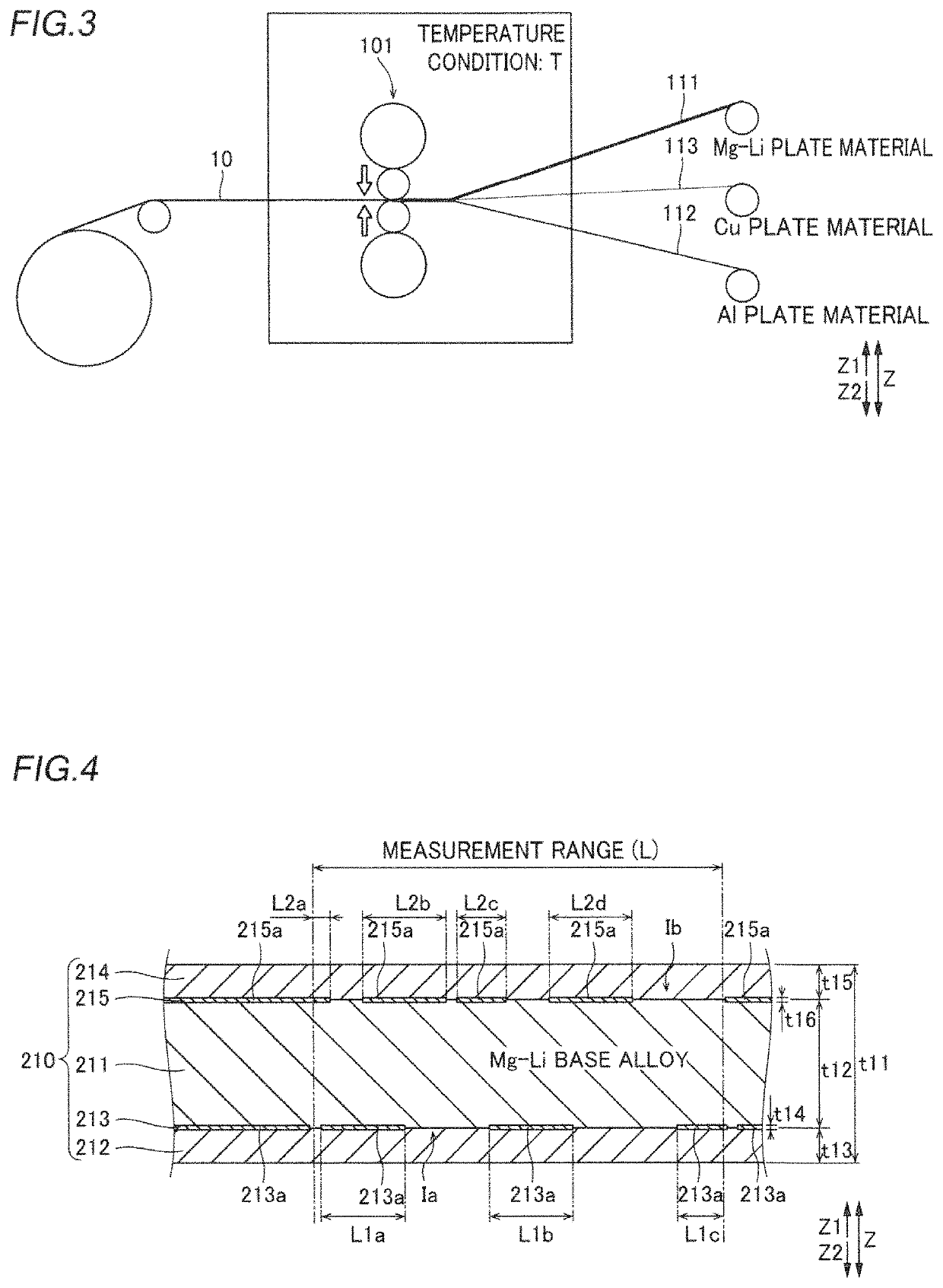Clad material and electronic device housing
a technology of electronic devices and cladding, which is applied in the direction of manufacturing tools, transportation and packaging, and solventing apparatus, can solve the problems of low corrosion resistance of mg base alloy and the likelihood of layer separation from each other, and achieve the effect of suppressing an increase in its specific gravity and ensuring bonding strength
- Summary
- Abstract
- Description
- Claims
- Application Information
AI Technical Summary
Benefits of technology
Problems solved by technology
Method used
Image
Examples
first embodiment
[0042]
[0043]The structure of an electronic device 100 according to a first embodiment of the present invention is now described with reference to FIGS. 1 and 2.
[0044]The electronic device 100 according to the first embodiment of the present invention is a portable electronic device, for example. This electronic device 100 includes a box-shaped housing 1 used as a structural member of the electronic device 100, a substrate 2 arranged on the housing 1, and a display 3 that is connected to the substrate 2 and displays an image etc. The housing 1 is an example of an “electronic device housing” in the claims.
[0045](Structure of Clad Material)
[0046]The housing 1 is made of a clad material 10, as shown in FIG. 2. Specifically, the housing 1 is made of the clad material 10 including a Mg—Li layer 11, an Al layer 12, and a bonding portion 13. In the clad material 10, the Mg—Li layer 11 and the Al layer 12 are bonded to each other in a state where the same are stacked in this order from a Z1 ...
second embodiment
[0074]A second embodiment of the present invention is now described with reference to FIG. 4. In the second embodiment, the case where a clad material 210 has a five-layered structure is described.
[0075]
[0076]According to the second embodiment, the clad material 210 includes an Al layer 214 and a bonding portion 215 in addition to a Mg—Li layer 211, an Al layer 212, and a bonding portion 213. In the clad material 210, the Al layer 214, the Mg—Li layer 211, and the Al layer 212 are bonded to each other in a state where the same are stacked in this order from a Z1 side to a Z2 side. Furthermore, the bonding portion 213 is arranged on a bonding interface Ia between the Mg—Li layer 211 and the Al layer 212 on the Z2 side in a section view when the clad material 210 is cut in a thickness direction (direction Z). In addition, the bonding portion 215 is arranged on a bonding interface Ib between the Mg—Li layer 211 and the Al layer 214 on the Z1 side in the section view. The Mg—Li layer 21...
examples
[0096]An experiment and a simulation conducted in order to confirm the effect of the present invention are now described with reference to FIGS. 3 to 20. As the experiment, measurement of the abundance of the bonding portion and measurement of the peel strength were performed. As the simulation, the specific gravity of the clad material with respect to the thickness percentage of the Mg—Li layer in the case where the thickness of the clad material and the thickness of the bonding portion were set to predetermined values was obtained.
[0097]
[0098]First, the clad material 210 according to Example 1 that corresponds to the aforementioned second embodiment was prepared. Specifically, first, a Mg—Li plate material made of LZ91 (Mg—Li—Zn alloy), a pair of Al plate materials made of A1080 (pure Al), and a pair of Cu plate materials made of C1020 (pure Cu) were prepared. The specific gravity of LZ91 is 1.50, the specific gravity of A1080 is 2.70, and the specific gravity of C1020 is 8.94.
[00...
PUM
 Login to View More
Login to View More Abstract
Description
Claims
Application Information
 Login to View More
Login to View More - R&D
- Intellectual Property
- Life Sciences
- Materials
- Tech Scout
- Unparalleled Data Quality
- Higher Quality Content
- 60% Fewer Hallucinations
Browse by: Latest US Patents, China's latest patents, Technical Efficacy Thesaurus, Application Domain, Technology Topic, Popular Technical Reports.
© 2025 PatSnap. All rights reserved.Legal|Privacy policy|Modern Slavery Act Transparency Statement|Sitemap|About US| Contact US: help@patsnap.com



